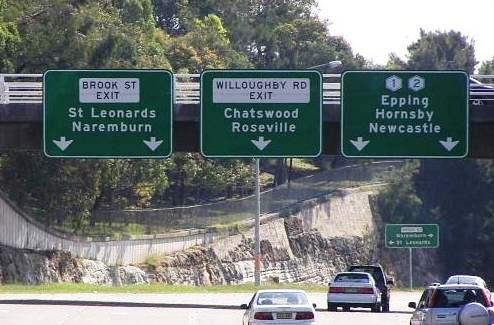 |
Australia - New South Wales Location: Warringah Freeway, Sydney.
Overhead signage is absent on rural roads in NSW, but you get to see it Sydney. The hexagonal "1" and "2" are metroads, metropolitan roads. Metroad 1 will eventually take you onto the Pacific Highway for Brisbane. Exits is Sydney are named after the road you'd get onto. |
|
Australia - Queensland Location: M1 (Pacific Motorway, Brisbane - Sydney)
Overhead signage is quite rare in Queensland. |
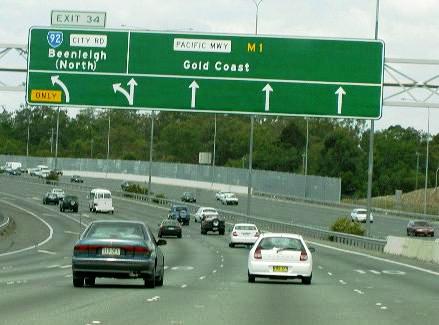 |
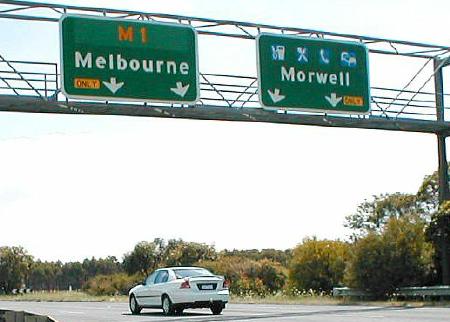 |
Australia - Victoria Location: M1 (Princess Fwy, coastal road from Melbourne - Sydney).
Oddly, this exit is one of the turn-off-to-stay-on series. The wording "only" on the outer lanes means that the drivers on those lanes are not supposed to switch directions anymore. The services on the exit are on a blue background, as usual in Victoria and elsewhere in Australia. |
|
Australia - Western Australia Location: SR2 (Perth - Joondalup)
WA uses gantry signage for complicated situations, such as this one with two exits in rapid succession. The sign features road numbers, road names (in smallcaps on a white background) and the destinations for the various directions. The bus lane is a bonus on this pic ... |
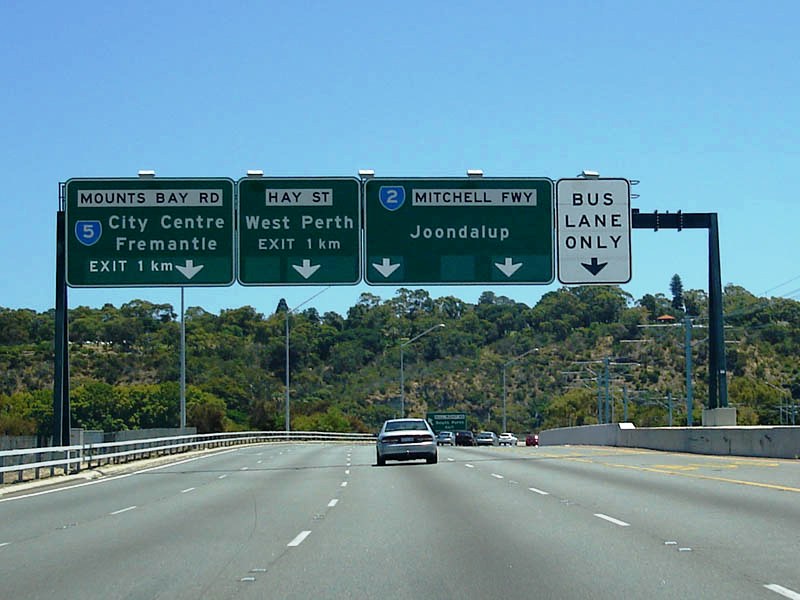 |
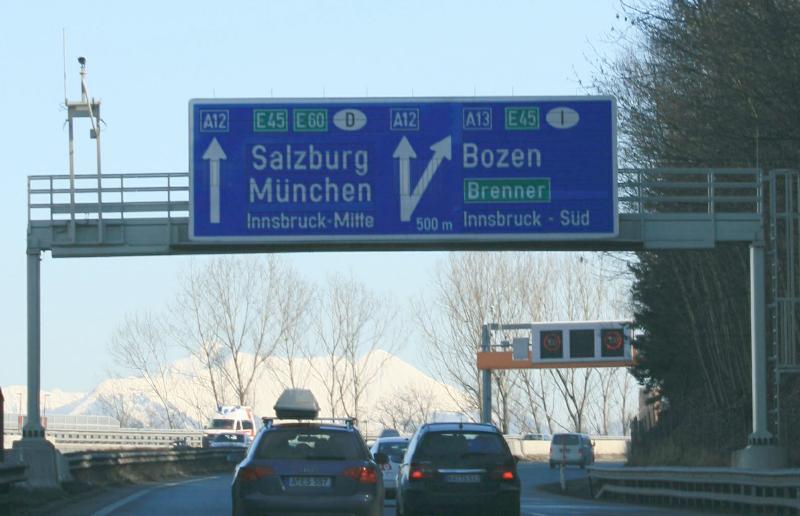 |
Austria Location: A12 (Landeck - Rosenheim). Is there anything sensible you can say about this mess? National road numbers and European road numbers are shown. This being the intersection between roads to Germany and Italy (even though you would have taken a completely different direction for some parts of Germany and Italy), I and D ovals are also shown in order to indicate that you are on your way to these nations. "Brenner" is printed against a green background, because it is not a town but a mountain pass. The directions to the various parts of Innsbruck are local destinations. Because of their lesser importance at an intersection like this, they are shown in a smaller print. |
|
Belgium - Flanders Location: R1 (Antwerp ring road)
One of the most ugly types of signs that I know ... just personal. Gent and Brussel (Brussels) are two separate destinations. The text in black-on-white on top indicates that this is the Antwerp ring road, the "1" on the top left does the same, designating that you're going clockwise ("2" is anti-clockwise). |
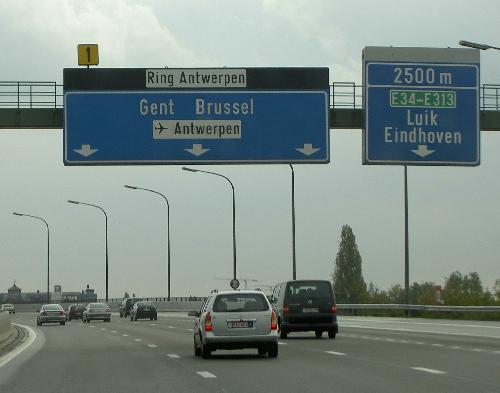 |
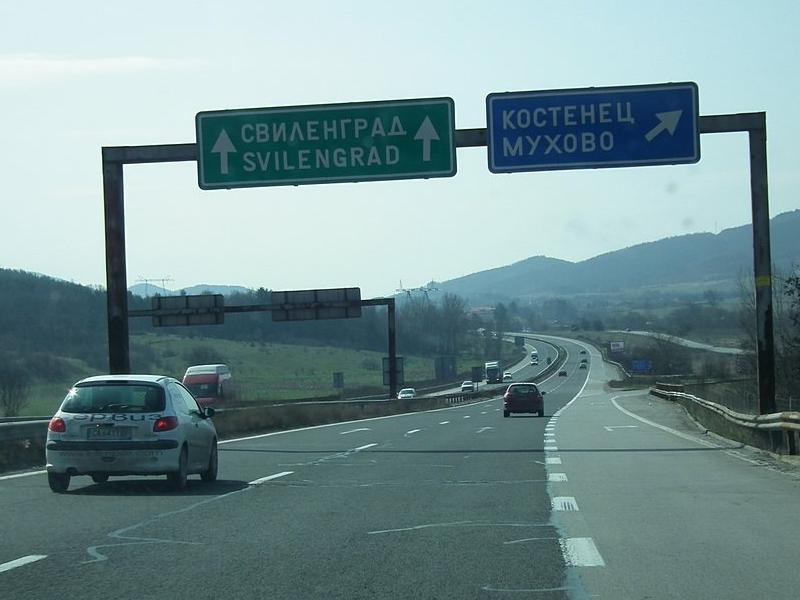 |
Bulgaria Location: A1 (Sofia - Svilengrad - Istanbul)
The exit sign in Bulgaria is generally overhead |
|
Canada - Ontario Location: King's Highway 401 (Windsor - Montréal)
Driving direction and control city on the pull-through sign. Some more directions on the exit sign. There is not much of a colour scheme in Canada. Almost every sign is green. |
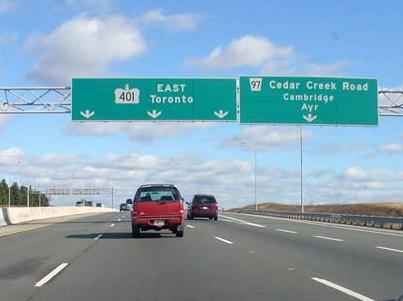 |
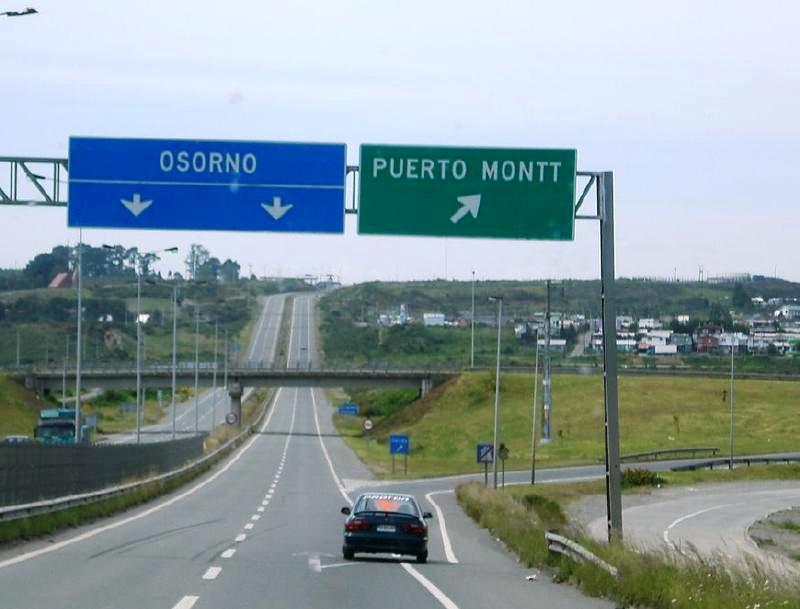 |
Chile Location: RN5: Ruta Panamericana (Puerto Montt - Santiago - Peruvian border)
While most ID signs in Chile are overhead, not all of them include a pull-through sign, like this one does. For the road ahead, you'll get to see one or two forward destinations and no route number. Destinations and lane allocation are always separated by a horizontal line. This is an older sign, as is evidenced by the use of capitals only. Newer signs, particularly prominent in Santiago, use normal capitalisation. |
|
China Location: Beijing Airport Expressway
Overhead sign with all relevant directions. Overhead signage is not very common, at least not in the sense that all directions receive a complete gantry. |
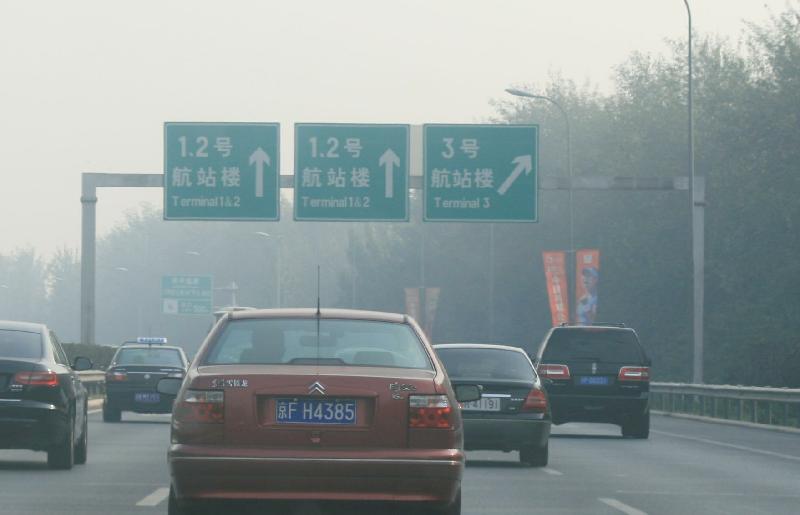 |
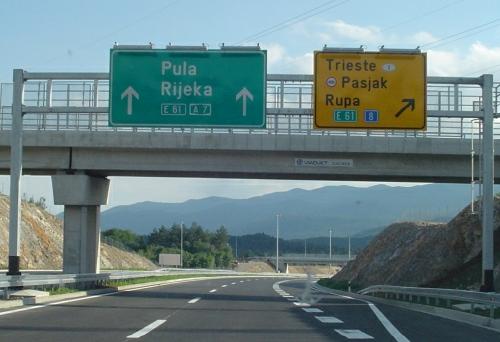 |
Croatia Location: A7 (Ljubljana - Rijeka)
Same sign as the exit sign. |
|
Czech Republic Location: D1 (Praha - Brno)
Same shield as the last shield before the exit. |
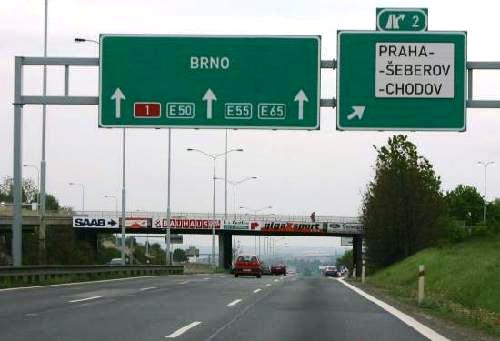 |
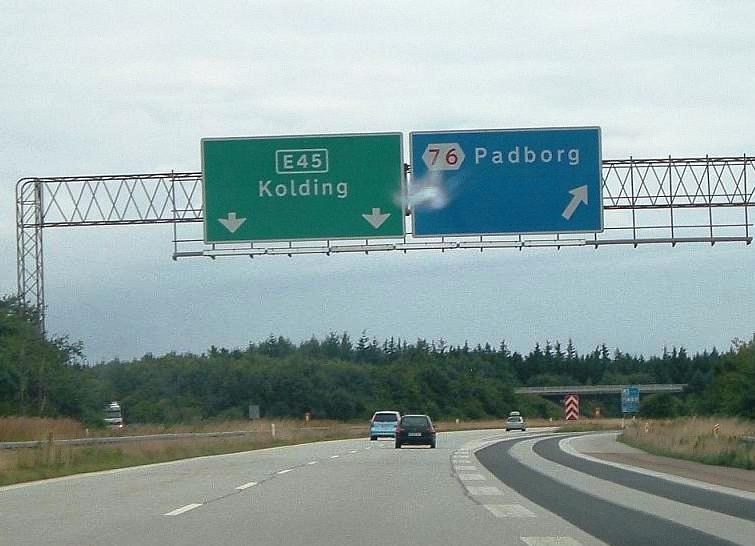 |
Denmark Location: E45 (Flensburg - Arhus)
Nothing special. Note that Denmark only uses an European road number for its motorways. There are national numbers, but these are for administrative use only and are not being signposted. Overhead signage is rather scarce in Denmark. |
|
Finland Location: E75 (Helsinki - Lahti)
The exit sign shows the shields for three types of road here, with the shield for road number 51 being dashed. This means that the intersection leads towards the road, but won't get you onto it yet. You get to see trailblazers with such dashed shields too. |
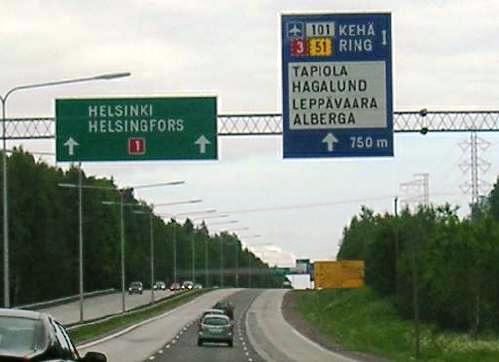 |
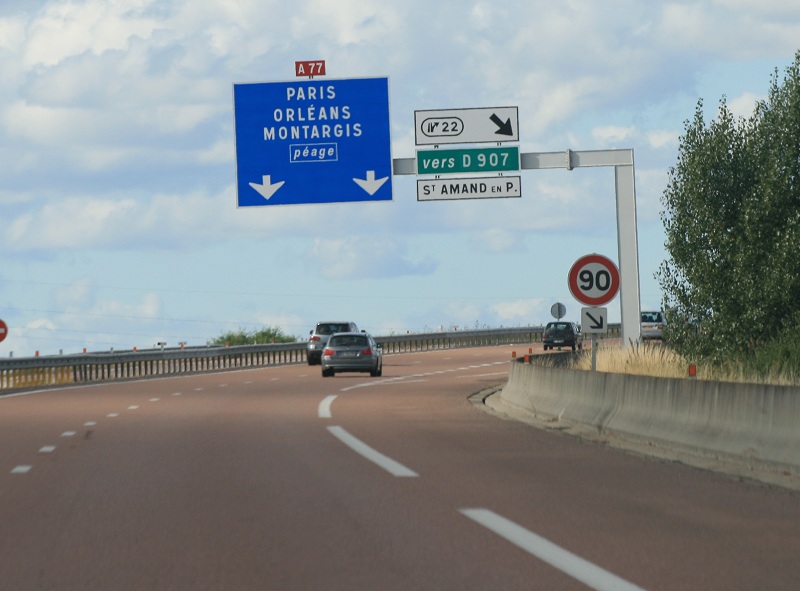 |
France Location: A1 (Autoroute du Nord, Paris - Lille).
The same sign as the last one before the exit, since exit signs are always overhead in France. These overhead signs always shows up to four destinations for the road ahead. The next exit is often one of them. The concept of a control city is not really known in France. |
|
Germany Location: A61 (Ludwigshafen - Venlo).
Overhead pull-through signs differ as per the situation. Sometimes, like on this sign, pull through information is limited to the name of the next exit. Other overhead signs give further information, such as larger cities ahead. Some German states use overhead signs quite heavily, others do not. |
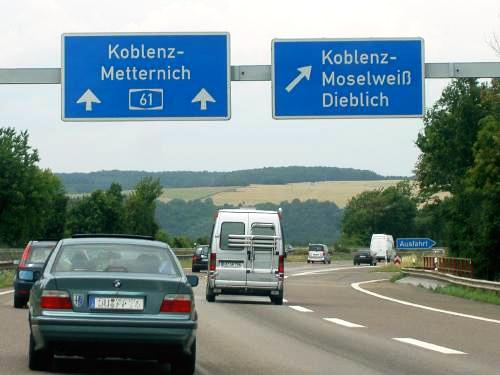 |
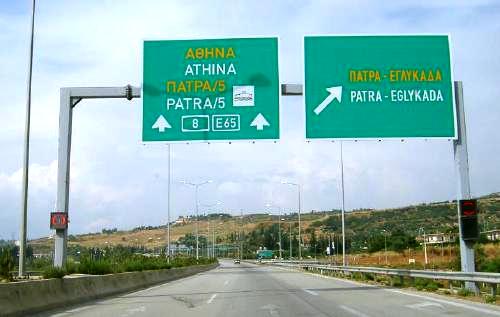 |
Greece Location: A8 (Patras - Athens)
Straightforward exit sign. |
|
Hungary Location: M7 (Budapest - Zagreb)
This is a bit of an odd one in that this sign tells truck drivers to get off, but this type of fullish signs are common on Hungarian overhead signs. Road numbers, indicators of other countries, customs signs, it's all over. |
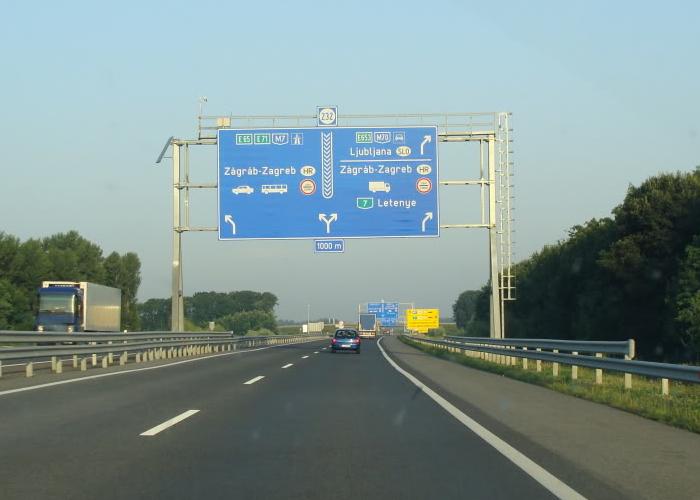 |
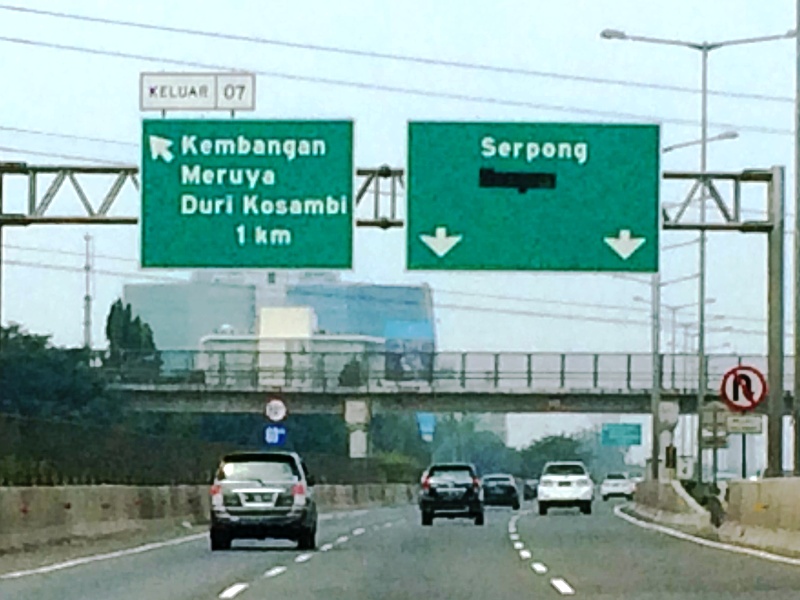 |
Indonesia Location: Jakarta Ring Road
Gantry signs are commonly used on Indonesia's motorways. Road numbers (both national and Asian Highways where relevant) are still missing on the signs. The arrows do not fully reflect the actual situation here, as the outer lane equally serves the road ahead. |
|
Iran Location: Motorway 2 (Tehran - Tabriz)
Gantry signs, which are common in urban areas above all, are the only signs in Iran where you get to see the use of colour coding at work. Blue is for motorways, green for major highways and white for local roads. |
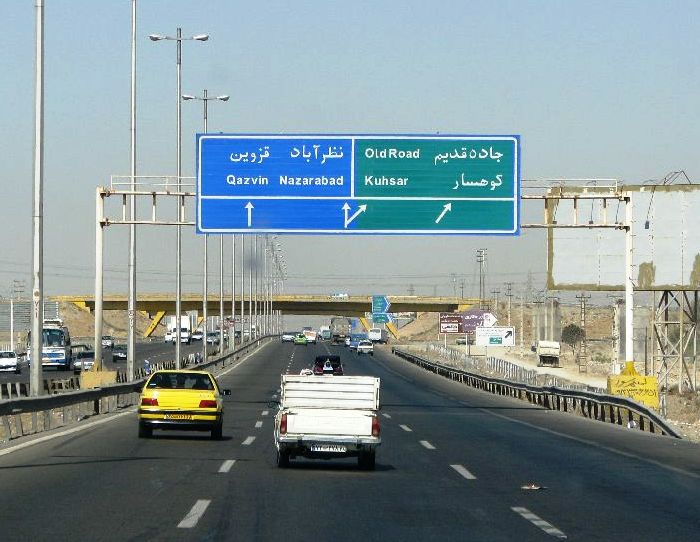 |
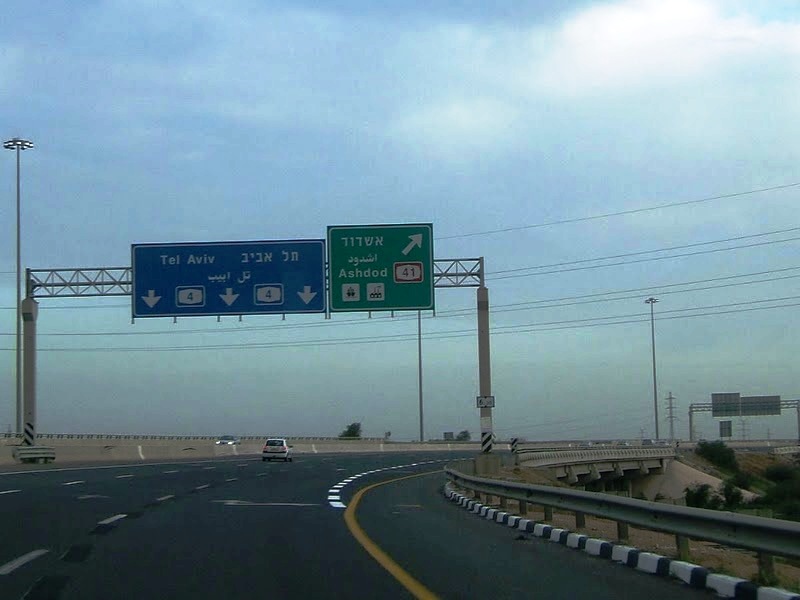 |
Israel Location: Hwy 4 (Tel Aviv - Gaza)
Blue sign for the road ahead, green sign for the intersecting non-motorway. Road numbers are included for both the exit and for the road ahead. Only when a gantry sign is placed, drivers get information about the road ahead prior to the exit. That part of the system is clearly US-orientated (you'd also be amazed to see a lot of "exit only" marks on a lot of overhead signs). The use of different colours for different types of roads is very European, which makes Israel a quite interesting signing mixture. |
|
Italy Location: A1 (Napoli - Milano) Even though the exit signs are always overhead, there also is a different type overhead sign. This type of sign is mostly used around major towns or at motorway intersections, where a large number of destinations need to be listed. This sign is placed where you enter the Milan ring road from the South, and directions are posted to all major roads outgoing from Milan. For the road ahead, too, you finally see more than only the control city as you would otherwise in Italy. |
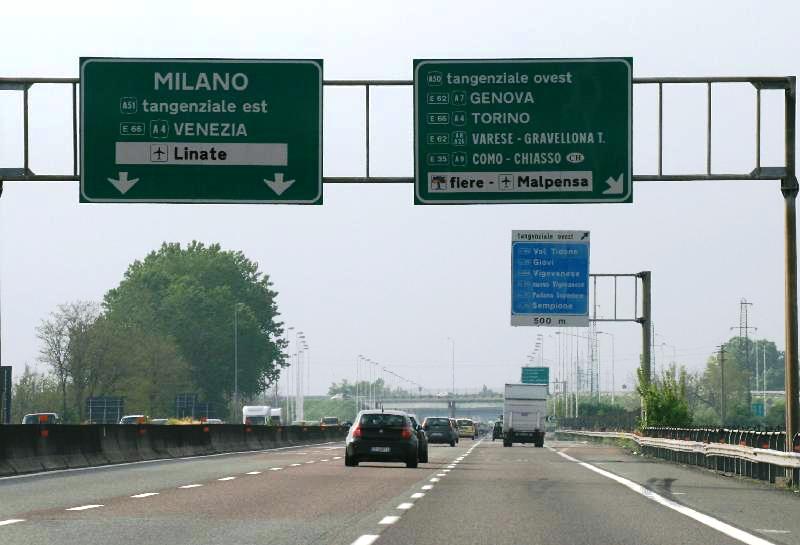 |
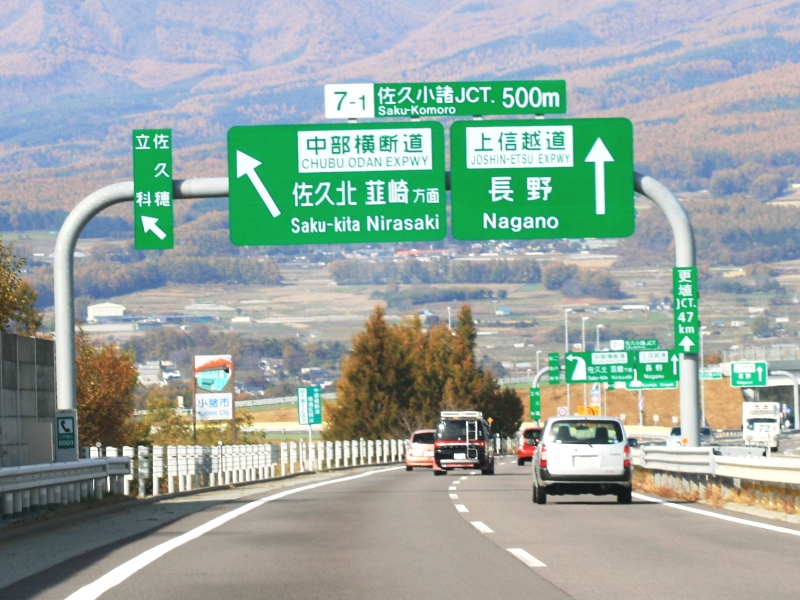 |
Japan Location: Chuo Expressway (Tokyo - Nagoya) This type of sign is commonly employed at motorway junctions in Japan. The arrows do not reveal any lane allocation. Name and number of the intersection are placed on a separate sign at the top. Outside of urban motorways, full gantry signs are pretty much limited to expressway intersections. They are the one place on expressway where you will find the expressway name repeated. Having said this, many regular signs are placed overhead for better visibility. |
|
Korea Location: NH10 (Busan - Mokpo) Gantry signs were previously used for many purposes in South Korea, but they are being phased out. On motorways, you will generally come across them at motorway intersections, where pull-through information or information about lane allocation is required. The information for the exit is much comparable to the usual ID sign. For the route ahead, it's route number, cardinal direction (at the top of the route number) and the control city of the road ahead. |
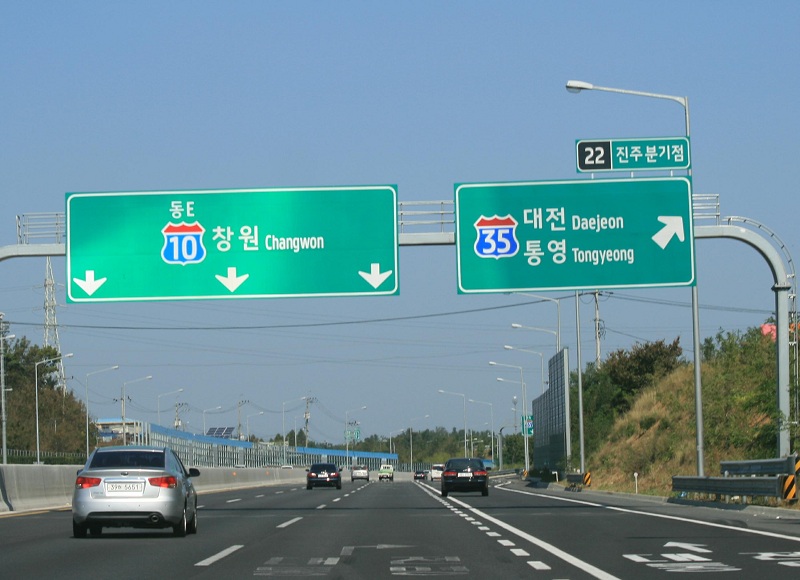 |
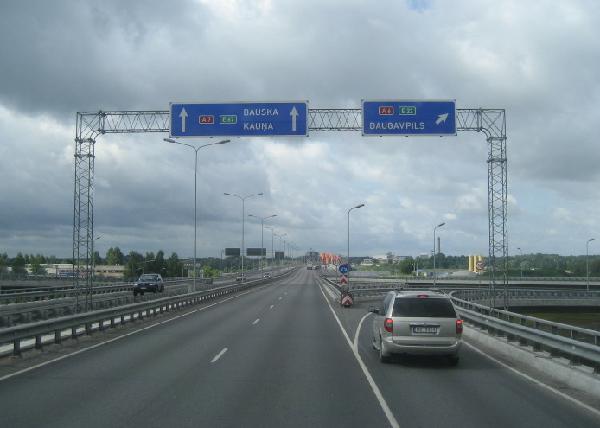 |
Latvia Location: A7 (Bauska - Riga)
Overhead signage in Latvia is rare, but where else to find it but in the capital Riga. Unlike other directional signage, there is place on the gantry for European road numbers. For the rest, simple arrows, simple colours and the destinations. Nice and easy sign, really. |
|
Lithuania Location: A1 (Klaipeda - Vilnius)
One arrow for the road ahead, even though that road ahead takes three lanes. In other words, the Lithuanian overhead signs do not give you the lane allocation. Signs show national road numbers (note the similarities to the road numbers elsewhere in the Baltics) and Warsaw in two languages (just not in English). |
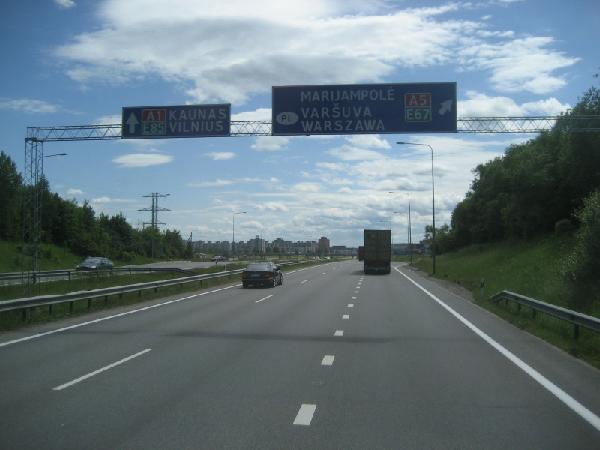 |
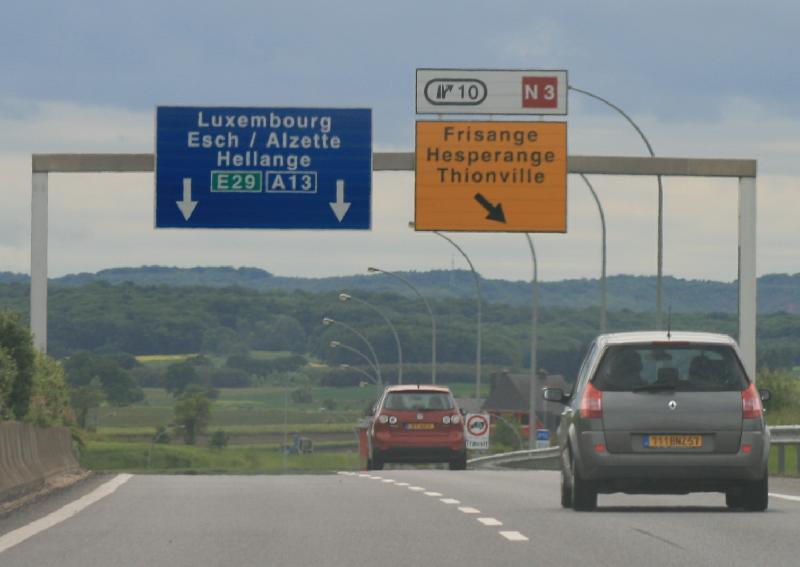 |
Luxembourg Location: A13 (Luxembourg - Longwy). The same sign as the last one before the exit, since exit signs are always overhead in Luxembourg. The pull-through sign shows both the European road number (in green) and the national road number (in blue). Older Luxembourg signs show no road numbers. |
|
Macedonia Location: E75 (Skopje - Athens)
The ID sign is always overhead in Macedonia. |
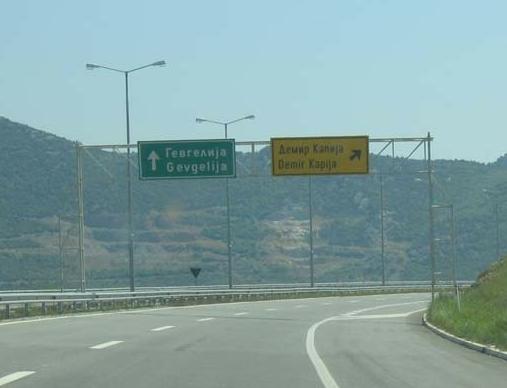 |
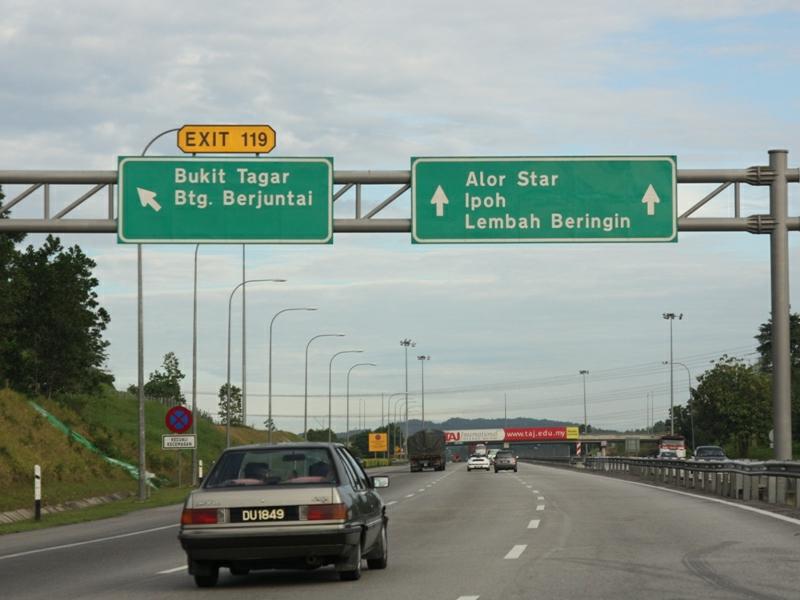 |
Malaysia Location: E1 (Kuala Lumpur - Ipoh)
Lane allocation does not match, so the arrows say little more than "exit for exit 119" and "straight ahead for the rest of the world". The numbers of the intersecting road are not signposted here. |
|
Mexico Location: MEX-180d (Cancún - Merida) Lots of overhead signage. This is just one of the types of overhead signage, the sign used to tell traffic about to turn off that they should take the right-hand lane. |
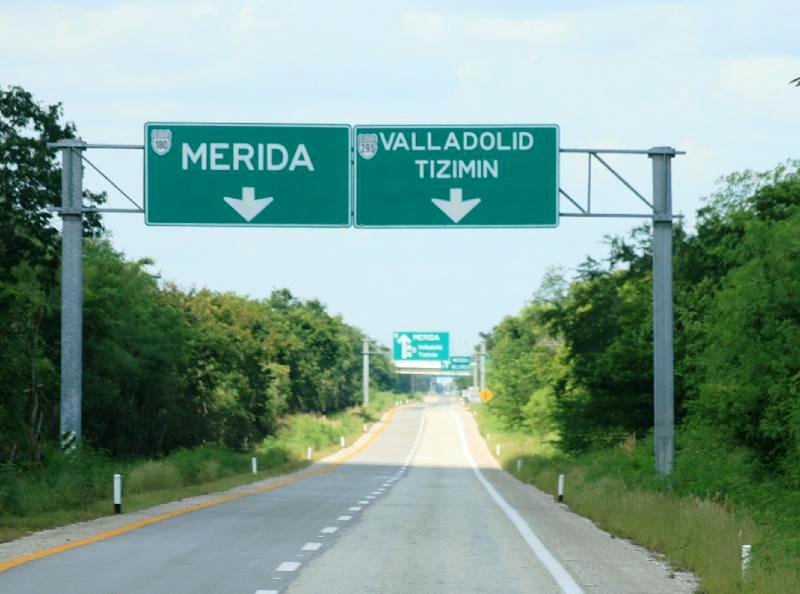 |
Motorway signs
All Rights Reserved